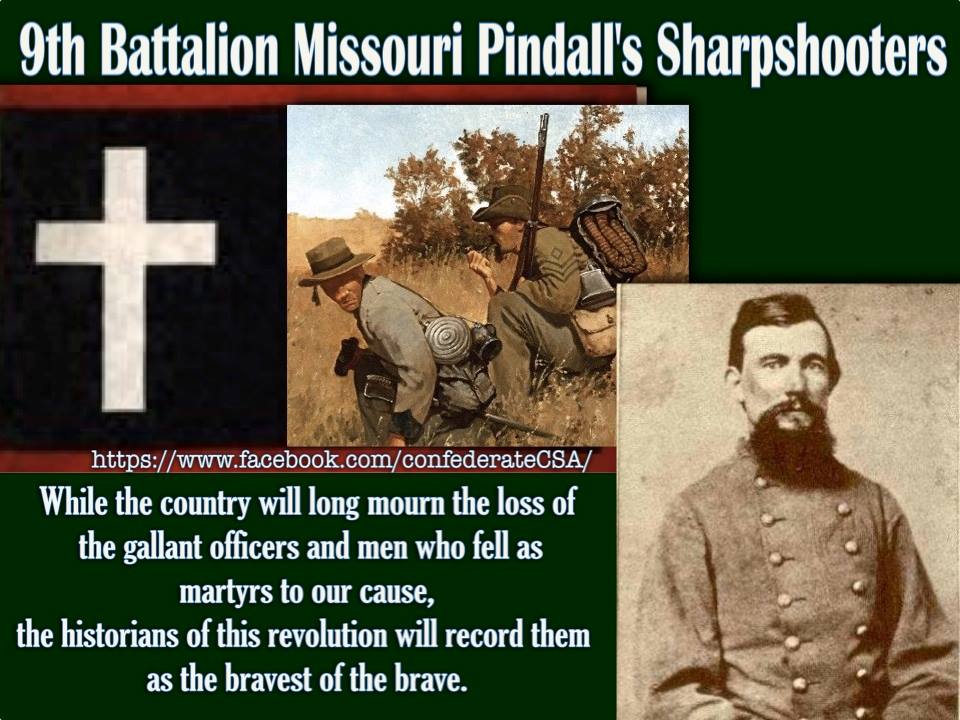
9th Battalion Missouri Sharpshooters, CSA
Pindall’s Sharpshooters was formed at Ft. Smith, Arkansas in 1862. It was officially designated 9th Missouri. Initially three companies were formed from existing units such as Reaves Partisan Rangers and Captains Foster’s Missouri Battery formed Company A of Pindall’s Sharpshooters.
The 9th Battalion Missouri Sharpshooters was later assigned to Burns’ Brigade, Parsons’ Division and lastly to the 1st Missouri Brigade, 1st Missouri Division, 2nd Corps, Trans-Mississippi Department. This unit served throughout the war until Kirby Smith surrendered the Trans-Mississippi Department. The 9th was included in the surrender and its men were paroled on June 7, 1865.
9th Missouri Sharpshooters uniforms:
The Confederate Quartermaster depot system was painfully slow in starting in the Trans-Mississippi department. These are the various depots that may have supplied the 9th Missouri:
• Baton Rouge (LA). • Little Rock (ARK). • Jackson (MS). • Enterprise (MS). • Houston (TX). • Shreveport (LA). • Columbus (MS). • Imported equipment from Great Britain.
At the beginning of the war some confederate soldiers wore homemade uniforms sent to them or clothing they brought with them from home until the depot system was up and running. In addition to what was brought from home or provided by the individual states, captured US uniforms and equipment were used to fill in the gaps until the depots were working.
Battle-Shirt, Frock Coat, Penitentiary Jacket, Depot Jackets or a Commutation Jacket (the latter a term used to encompass any jacket worn by a soldier, but not issued to him through the government). These would have been made out of Jean wool, British Cadet Grey Kersey wool, and various other weaves of wool. The use of 100% wool should be limited as it was hard to come by due to the union blockade. The various colors that were utilized for a uniform were Drab Butternut, Confederate Grey, Tuscaloosa Grey, Cadet Grey, Gray Jean Wool, Brown Jean Wool, Dove Gray Broadcloth Grey Mix, and Bleached White Jean Wool.
*For the Reenactor on a tight budget and active in warmer weather you might want to start with a Battle-Shirt. This is an over-shirt decorated with different types of trims and worn over a shirt, thus over-shirt. Battle-Shirts were extremely popular early in the war in all theaters and continued to be popular in the Trans Mississippi. The rest of the battle-shirt uniform can be completed with civilian or military trousers and hat. *
Trousers, depot patterns – should be made of the same material and colors as the Jackets and coats, but not necessarily matching in fabric. Also, possible are Union army trousers and Civilian patterns. Buttons may be of bone or pewter.
Shirts – Came in a variety of colors, such as bleached white, blue linen drill, and etc. The soldier also used homemade shirts. For homemade shirts, draw inspirations from appropriate soldier photos.
Accoutrements
Leather or painted cloth
Cartridge box, cap pouch, bayonet frog, and belt of Depot pattern were issued in black or russet color in the Trans-Miss. theater. The majority of soldiers were not issued a cartridge box sling, instead they wore the cartridge box on a simple waist belt along with their other accouterments. The most common belt was the simple harness style with a roller buckle used to fasten it. However, other types of belts and patterns of gear were issued to the soldiers. These included captured Union Army items and British Army equipment brought though the Naval Blockade.
Shoes – Depot Brogans (pegged), or British Import Brogans (sewn and/ or nailed soles- not pegged). Russet brogans were atypical, and were viewed as slave shoes.
Hats – Photos and sketches of the Trans-Mississippi soldier show an interesting array of patterns. Kepis appear to have been common for late war Trans- Mississippi Confederate. These Kepis were left either plain or featured a branch of service band as per the depot styles they came from. Buttons and chinstraps were seldom present in an effort to economize the manufacturing process of the cap. The most common hat was either a flat or round crowned, dark colored slouch hat. The few surviving mid to late war portrait photos of common Trans-Mississippi soldiers show that most slouch hats appear black, with slightly more flat crowned than round-crowned designs.
Canteen – The most common artifacts dug up in the Trans-Mississippi camps is the typical 6” flat tin drum canteen. Most of these would have had leather straps and a stopper of cork or wood. Other canteen designs were round wooden manufacture or captured Union canteens, a possible host of other styles are appropriate.
Haversack – Plain linen or white cotton with a button closure were the most common.
Knapsack- Either the Mexican war (or kibbler) single bag style, a British import or a captured union double bag Knapsack were all used in this theater of war.
Blanket – Some blankets came from home and were of a civilian pattern. Later in the war soldiers were issued British imports and of course captured union types.
Weapons – The best choices are the 1842 Springfield Musket (smoothbore or rifled), British Enfield Rifle or a captured 1861 Springfield. There were other rifles and muskets used as well in the Trans-Mississippi Department, but these are the most commonly available reproductions.


